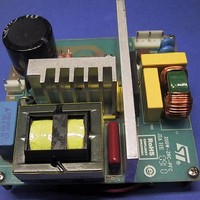EVL6563S-200ZRC STMicroelectronics, EVL6563S-200ZRC Datasheet - Page 7

EVL6563S-200ZRC
Manufacturer Part Number
EVL6563S-200ZRC
Description
Power Management Modules & Development Tools Tranisition Mode PFC L6563S EVL Board
Manufacturer
STMicroelectronics
Type
Motor / Motion Controllers & Driversr
Datasheet
1.EVL6563S-200ZRC.pdf
(39 pages)
Specifications of EVL6563S-200ZRC
Product
Power Management Modules
Lead Free Status / RoHS Status
Lead free / RoHS Compliant
AN3180
Figure 5.
Similarly, considering the model of
αv(t), it is equally apparent that, in order for the primary ripple current to be zero the voltage
across the inductance L
the same:
Equation 4
If in
the coupled inductor, we find the above mentioned assertion. As α=1 is the most common
condition found in switching converters, from now on this is the only case that is taken into
consideration, therefore:
●
●
Note that, as k < 1, to obtain a zero-ripple secondary current it must be n
L
ripple current cannot be reduced to zero in both windings simultaneously. In
note also that the inductance of the winding, where zero-ripple current is achieved, is
irrelevant, since there is no ripple current flowing (only DC current can flow). As a
consequence, the zero-ripple current winding reflects an open circuit to the other one, so
that the inductance seen at the terminals of that winding equals exactly its self-inductance.
The designation of which winding is the primary or the secondary is purely conventional.
Therefore, we consider only one zero-ripple current condition and arbitrarily assume the
condition to be assigned to the secondary winding:
Equation 5
which, consistent with the terminology used for the smoothing transformer of
termed DC winding, while the primary winding is termed AC or cancellation winding.
Equation 5
1
, while to obtain a zero-ripple primary current it must be n
Equation 3
k
k
n
=
e
n
=
, considering
e
1
Coupled inductor a = n
and
condition for zero-ripple primary current
condition for zero-ripple secondary current
4
α=1, which means that equal voltages are impressed on either side of
1
Equation 1
v
(1-k
) t (
=
2
Doc ID 17273 Rev 1
) must be zero, that is, the voltage on either side of it must be
n
k
e
α
Figure 5
v
) t (
and
e
/k model under zero-ripple current conditions
2
⇒
can be written in different equivalent ways:
k
, again excited by proportional voltages v(t) and
n
e
n
k
e
=
α
Zero-ripple current phenomenon: theory
1
=
1
⇒
k
e
α
< 1, that is L
=
n
e
e
1
> 1, that is L
> L
Figure 4
Figure 3
2
; and so
and
, is
2
7/39
>
5
,















